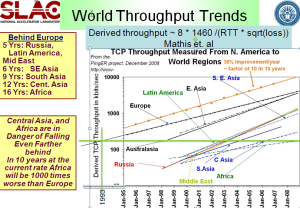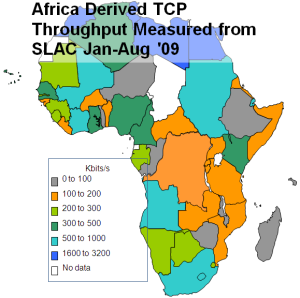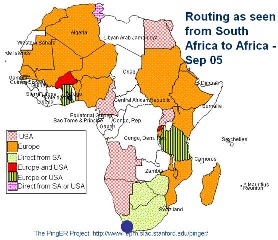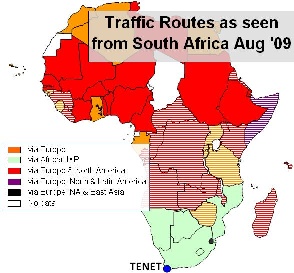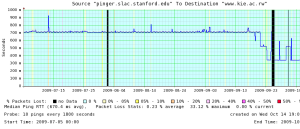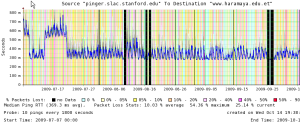...
<ac:structured-macro ac:name="unmigrated-wiki-markup" ac:schema-version="1" ac:macro-id="04de399ef9a39f15-927feb72-4f2844e3-977a8219-4ea0ba949207f70f51109118"><ac:plain-text-body><![CDATA[ | Throughput from SLAC to Regions of the World | Derived Throughput from SLAC to Africa Jan-Aug '09 [[xlsx | ^africa-thru-aug09.xlsx]] | MinRTT from SLAC - Aug. 2009 [[xls | ^map-africa-minrtt-aug2009.xls]] | ]]></ac:plain-text-body></ac:structured-macro> |
|---|---|---|---|---|---|---|
|
|
|
...
<ac:structured-macro ac:name="unmigrated-wiki-markup" ac:schema-version="1" ac:macro-id="969d057e434d2fd4-0885c47d-40f746c7-b8b2ad89-deba8535e794482218ca2d29"><ac:plain-text-body><![CDATA[ | Routing from South Africa to African Countries (Sep '05) | Routing from South Africa to African Countries (Aug '09) [[xls | ^routing-africa-aug2009.xls]] | Routing from Burkina Faso to African Countries (Aug '09) [[xls | ^routing-africa-aug2009.xls]] | ]]></ac:plain-text-body></ac:structured-macro> |
|---|---|---|---|---|---|---|
| |
|
...
Uganda should be connected soon. KDN was building the fiber to Uganda and Rwanda. We therefore also set up a group for countries in the UN definition of Eastern Africa to simplify reviewing minimum RTT for all East Africa.
...
Kenya
...
On Aug 2, 2009 following an email from Don Riley who had detected that kdn.co.ke had dropped to 370ms. We were Unfortunately not monitoring kdn.co.ke. However on further investigation we found the RTT from SLAC to acheraarchitects.co.ke (see below) had changed between 14:00 and 17:00 hours 6/1/09 GMT from a steady 716 ms to a steady 325ms. This is exactly what one would expect as the route moves from a GEOS to a terrestrial line. The traceroute from SLAC to Kenya went via ESnet to Sunyvale, then via Level3 to New York and London and thence to Kenya. The RTT between London and Kenya was about 200ms.
...
On August 3, around 19:00 hours elearning.braeburn.ac.ke dropped from about 750ms to about 400ms (see below). The traceroute from SLAC to Braeburn is different from that to www.ku.ac.ke. It goes from SLAC via Esnet to Sunnyvale, crosses to Teleglobe and then to AS6453 to get to London. AS6453 is GLOBEINTERNET TATA Communications. In Kenya one of the nodes is Access Kenya which according to http://www.accesskenya.com/ "Access KenyaNews: ACCESSKENYA SETS AMBITIOUS TARGET OF 1MB GUARANTEED SPEED FOR THE AVERAGE CUSTOMER. ACCESSKENYA UPGRADES CORE NETWORK IN PREPARATION OF SEACOM AND TEAMS CAPACITY" (their capitalization.
More details on the Kenyatta University (www.ku.ac.ke) and Braeburn (elearning.braeburn.ac.ke) links can be found in an email from Kevin Chege of KENET.
...
Rwanda
...
Between the 22nd and 25th of September the RTT from SLAC to The Kigali Institute of Education host www.kie.ac.rw in Kigala, Rwanda dropped by a factor of 2 from 720msec to 320msec (see below). The connection was through Kampala Uganda to Kenya. The traceroute appears to go via Austria.
...
Tanzania
...
By August 3rd, the average RTT from SLAC to mail2.starcom.co.ug in Kampala Uganda reduced from about 780ms to about 540ms. On August the average RTT dropped further to about 380ms. Possibly in the intermediate state (540ms) only one direction was using the fibre. The traceroute measured on 8/15/09 shows the route going via ESnet to Sunnyvale then onto San Jose and Level3 that carries it to New York and London, the next hop is in Nairobi an Intersat Africa node. Hop 18 is also in Nairobi and hop 19 in Kampala. Looking at the time series of the average RTT below it is not clear the route has fully stabilized yet.On the 26th September 2009 the RTT from SLAC to www.acet.or.tz in Dar Es Salam Tanzania dropped from about 720msec to about 310msec (see below).Between the 22nd and 25th of September the
...
Uganda
...
By August 3rd, the average RTT from SLAC to The Kigali Institute of Education host www.kie.ac.rw dropped by a factor of 2 from 720msec to 320msec (see below). The connection was through Uganda to Kenya. The traceroute appears to go via Austria. mail2.starcom.co.ug in Kampala Ugandareduced from about 780ms to about 540ms. On August the average RTT dropped further to about 380ms. Possibly in the intermediate state (540ms) only one direction was using the fibre. The traceroute measured on 8/15/09shows the route going via ESnet to Sunnyvale then onto San Jose and Level3 that carries it to New York and London, the next hop is in Nairobi an Intersat Africanode. Hop 18 is also in Nairobi and hop 19 in Kampala. Looking at the time series of the average RTT below it is not clear the route has fully stabilized yet.
In some cases such as Uganda Telecom (81.199.21.194) the losses and fluctuations in RTT went up dramatically after the changeover. In some cases such as Uganda Telecom (81.199.21.194) the losses and fluctuations in RTT went up dramatically after the changeover. In others such a library.uonbi.ac.ke and acherarchitects.co.ke the losses and stability appeared to improve.
More details on the Kenyatta University (www.ku.ac.ke) and Braeburn (elearning.braeburn.ac.ke) links can be found in an email from Kevin Chege of KENET.
acheraarchitects.co.ke | acheraarchitects.co.ke | ealearning.braeburn.ac.ke | www.ku.ac.ke from SLAC | library.uonbi.ac.ke 3 Aug - Sep 9, '09) |
|---|---|---|---|---|
|
|
|
| |
www.acet.or.tz |
|
|
| |
|
|
|
| |
mail2.starcom.co.ug from SLAC | www.utl.co.ug from SLAC | Ugandatelecom.ug from SLAC |
| |
| | |
| |
www.kie.ac.rw from SLAC |
|
|
| |
|
|
|
|
...
Seen from ITCP TRieste Italy
...
If one compares the RTTs seen from SLAC to East Africa with those seen from ICTP in Trieste Italy which is much closer, then:
...
Similar effects (dramatic reduction in RTTs) have also been observed for other sites in south and eastern African countries.
...
Angola
...
For example on May 19th 2009, www.novagest.co.ao one of 4 sites PinGER monitors in Angola reduced the average RTT from about 750ms to 450ms and became much more stable (less jitter) in the process (see the time series in the figure below). The traceroute goes via Globenet TATA Communications and then to the Angola Telecom IP backbone.
...
Ethiopia
...
The THe RTT from SLAC to www.haramaya.edu.et at the University of Addis Ababa in Dire Dawa, Ethiopia's second largest city (about 300km as the crow flies from the coast) on the railway line between Djibouti and Addis Ababa, dropped from about 580ms to 300ms on June 9th 2009 (see below).
...
Malawi
...
Malawi currently (10/13/09) has only GEOS access. The most likely terrestrial path will be via Mozambique to Maputo (the landing point for both Seacom and TEAMS) see the email from Bjorn Pehrson and the article by Telegeography.
...
Mozambique
...
Similarly the average RTTs of both hosts that PingER monitors in Mozambique (www.Similarly the average RTTs of both hosts that PingER monitors in Mozambique (www.uem.mz and www.micti.co.mz) dropped from 780ms to about 360 ms in May 2007.
...
Namibia
...
On the other hand hosts in Namibia (such as www.adsl.com.na seen below) seem to be switching between using a long RTT path from SLAC and a shorter one.
...
Zambia
...
Malawi currently (10/13/09) has only GEOS access. The most likely terrestrial path will be via Mozambique to Maputo (the landing point for both Seacom and TEAMS) see the email from Bjorn Pehrson and the article by Telegeography.
One host (www.aisha.ac.One host (www.aisha.ac.zm) of the 6 monitored in Zambia improved its RTT from about 720ms to 550ms on August 20, 2009 (see below). Also at the time of writing it looks like they are still moving the link over to the terrestrial lines since the performance is very unstable (high losses) and there are big changes in RTT. It is possible the link in one direction is using a GEOS while the other is an all terrestrial link and the large dips to 400ms are when both legs are using terrestrial links. We believe the terrestrial path goes via Botswana and Namibia. The traceroute from SLAC on 9/9/09 appeared to use a satellite link in at least one direction. On October 2, 2009 Mike Jensen reported that the traceroute from Rome to www.aisha.ac.zm was well below 450ms and thus appears to be a terrestrial link. However the tracreoute from SLAC was still taking over 550ms. Also the traceroute from TENET/Cape Town South Africa to www.aisha.ac.zm took over 650ms. The traceroute from NUST, Islamabad, Pakistan to mail.unza.zm takes less than 450ms and appears to be a terrestrial path going via Namibia. On October 7th 2009 the traceroute from SLAC to mail.unza.zm appeared to be terrestrial and went via Namibia.
Angola: www.novagest.co.ao | Ethiopia: www.haramaya.edu.et | Namibia: www.adsl.com.na |
|---|---|---|
| |
|
Zambia: www.aisha.ac.zm |
|
|
|
|
|
Fractional Conversion
The table below shows the number of hosts monitored from SLAC in the country and the number of those that used a terrestrial path as of a particular date.
|
|
| Monitored | Terresrial |
|
|
|
|---|---|---|---|---|---|---|---|
| Oldest Measured Data | 1st observed conversion | 10/17/09 | 10/17/09 |
|
|
|
Angloa | Oct 2006 | May 19, 2009 | 3 | 1 |
|
|
|
Botswana | Apr 2009 | None | 3 | 2 |
|
|
|
Ethiopia | Nov 2008 | June 9, 2009 | 7 | 1 |
|
|
|
Kenya | Feb 2005 | Aug 2, 2009 | 6 | 5 |
|
|
|
Lesotha | Feb 2005 | None | 2 | 2 |
|
|
|
Madagascar | Dec 2003 | None | 2 | 0 |
|
|
|
Malawi | Mar 2005 | None | 3 | 0 |
|
|
|
Mozambique | Dec 2003 | May 2007 | 2 | 0 |
|
|
|
Namibia | Feb 2007 | ? | 2 | 1 |
|
|
|
Rwanda | Mar 2005 | Oct 17, 2009 | 3 | 1 |
|
|
|
South Africa | Feb 2005 | None | 14 | 12 |
|
|
|
Swaziland | Oct 2007 | Feb 2009 | 3 | 1 |
|
|
|
Tanzania | Dec 2003 | Sep 26, 2009 | 5 | 1 |
|
|
|
Uganda | Nov 2003 | Aug 3, 2009 | 3 | 2 |
|
|
|
Zambia | Feb 2009 | Aug 20, 2009 | 6 | 1 |
|
|
|
Zimbabwe | Feb 2007 | None | 5 | 0 | |||
Angola: www.novagest.co.ao | Ethiopia: www.haramaya.edu.et | Namibia: www.adsl.com.na | Rwanda: www.kie.ac.rw | | |
| |
Zambia: www.aisha.ac.zm |
|
|
| ||||
|
|
|
|
Other Regions in Sub-Saharan Africa
...
